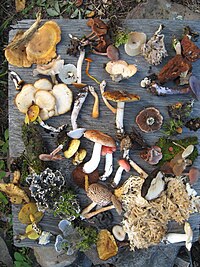
Photo from wikipedia
A new fossil pollen, Sporormiella, and sediment chemistry record from Lake Llaviucu, Ecuador, spanning the period from 16,280–9000 years Before Present, provides a high-resolution record of paleoecological change in the… Click to show full abstract
A new fossil pollen, Sporormiella, and sediment chemistry record from Lake Llaviucu, Ecuador, spanning the period from 16,280–9000 years Before Present, provides a high-resolution record of paleoecological change in the high Andes. The deglacial transition from super-paramo through paramo grasslands, to Andean forest is traced, with near-modern systems being established by c. 11,900 years ago. It is suggested that forest elements probably existed in microrefugial populations close to the ice front. Sporormiella is used as a proxy for megafaunal abundance, and its decline to background levels is inferred to indicate a local extinction event at c. 12,800 years ago. About 1800 years prior to the extinction, charcoal becomes a regular sedimentary component in this very wet valley. An early date for human activity in the valley is suggested, with the direct implication of humans in the extinction of the megafauna.
Journal Title: Quaternary Science Reviews
Year Published: 2019
Link to full text (if available)
Share on Social Media: Sign Up to like & get
recommendations!